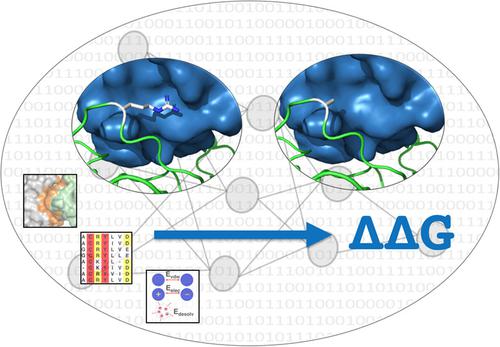当前位置:
X-MOL 学术
›
WIREs Comput. Mol. Sci.
›
论文详情
Our official English website, www.x-mol.net, welcomes your
feedback! (Note: you will need to create a separate account there.)
Finding the ΔΔG spot: Are predictors of binding affinity changes upon mutations in protein–protein interactions ready for it?
Wiley Interdisciplinary Reviews: Computational Molecular Science ( IF 16.8 ) Pub Date : 2019-01-15 , DOI: 10.1002/wcms.1410 Cunliang Geng 1 , Li C. Xue 1 , Jorge Roel-Touris 1 , Alexandre M. J. J. Bonvin 1
Wiley Interdisciplinary Reviews: Computational Molecular Science ( IF 16.8 ) Pub Date : 2019-01-15 , DOI: 10.1002/wcms.1410 Cunliang Geng 1 , Li C. Xue 1 , Jorge Roel-Touris 1 , Alexandre M. J. J. Bonvin 1
Affiliation

|
Predicting the structure and thermodynamics of protein–protein interactions (PPIs) are key to a proper understanding and modulation of their function. Since experimental methods might not be able to catch up with the fast growth of genomic data, computational alternatives are therefore required. We present here a review dealing with various aspects of predicting binding affinity changes upon mutations (ΔΔG). We focus on predictors that consider three‐dimensional structure information to estimate the impact of mutations on the binding affinity of a protein–protein complex, excluding the rigorous free energy perturbation methods. Training and evaluation, ΔΔG databases, data selection, and existing ΔΔG predictors are specially emphasized. We also establish the parallel with scoring functions used in docking since those share many similar PPI features with ΔΔG predictors. The field has seen a common evolution of ΔΔG predictors and scoring functions over time, transforming from purely energetic functions to statistical energy‐based and further to machine learning‐based functions. As machine learning has come to age, limitations in terms of quantity, quality and variety of the available data become the bottlenecks for the future development of these computational methods. This can be alleviated by building infrastructures for data generation, collection and sharing. Further developments can be catalyzed by conducting community‐wide blind challenges for method assessment.
中文翻译:

找到ΔΔG斑点:蛋白质亲和力相互作用突变后的结合亲和力变化的预测因子是否准备好了?
预测蛋白质-蛋白质相互作用(PPI)的结构和热力学是正确理解和调节其功能的关键。由于实验方法可能无法赶上基因组数据的快速增长,因此需要计算替代方法。我们在座的处理后预测突变(ΔΔ结合亲和力变化的各个方面进行审查g ^)。我们专注于考虑三维结构信息的预测因子,以评估突变对蛋白质-蛋白质复合物结合亲和力的影响,但不包括严格的自由能扰动方法。培训和评估,ΔΔ摹数据库,数据选择,和现有的ΔΔ g ^特别强调预测变量。我们还建立了与对接中使用的评分函数的并行关系,因为这些函数与ΔΔG预测变量共享许多相似的PPI特征。现场已经看到ΔΔ的共同进化摹预测和计分功能随着时间的推移,从单纯的充满活力的职能转变到基于统计的能源,并进一步基于机器学习的功能。随着机器学习的发展,可用数据的数量,质量和多样性方面的限制成为这些计算方法未来发展的瓶颈。可以通过构建用于数据生成,收集和共享的基础结构来缓解这种情况。通过开展社区范围的方法评估盲目挑战,可以促进进一步的发展。
更新日期:2019-01-15
中文翻译:

找到ΔΔG斑点:蛋白质亲和力相互作用突变后的结合亲和力变化的预测因子是否准备好了?
预测蛋白质-蛋白质相互作用(PPI)的结构和热力学是正确理解和调节其功能的关键。由于实验方法可能无法赶上基因组数据的快速增长,因此需要计算替代方法。我们在座的处理后预测突变(ΔΔ结合亲和力变化的各个方面进行审查g ^)。我们专注于考虑三维结构信息的预测因子,以评估突变对蛋白质-蛋白质复合物结合亲和力的影响,但不包括严格的自由能扰动方法。培训和评估,ΔΔ摹数据库,数据选择,和现有的ΔΔ g ^特别强调预测变量。我们还建立了与对接中使用的评分函数的并行关系,因为这些函数与ΔΔG预测变量共享许多相似的PPI特征。现场已经看到ΔΔ的共同进化摹预测和计分功能随着时间的推移,从单纯的充满活力的职能转变到基于统计的能源,并进一步基于机器学习的功能。随着机器学习的发展,可用数据的数量,质量和多样性方面的限制成为这些计算方法未来发展的瓶颈。可以通过构建用于数据生成,收集和共享的基础结构来缓解这种情况。通过开展社区范围的方法评估盲目挑战,可以促进进一步的发展。











































 京公网安备 11010802027423号
京公网安备 11010802027423号